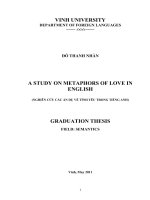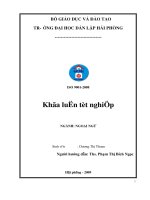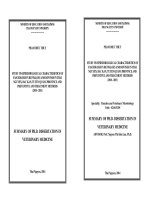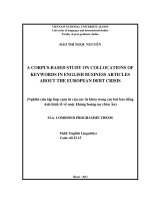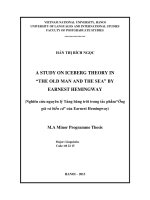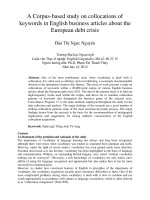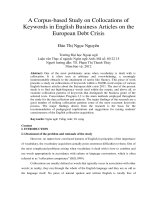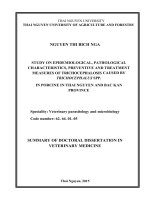STUDY ON LEUCOCYTOZOONOSIS OF CHICKENS IN THAI NGUYEN, BAC GIANG PROVINCE AND ITS PREVENTIVE, TREATMENT MEASURES
Bạn đang xem bản rút gọn của tài liệu. Xem và tải ngay bản đầy đủ của tài liệu tại đây (590.29 KB, 27 trang )
MINISTRY OF EDUCATION AND TRAINING
THAI NGUYEN UNIVERSITY
DUONG THI HONG DUYEN
STUDY ON LEUCOCYTOZOONOSIS OF CHICKENS IN THAI
NGUYEN, BAC GIANG PROVINCE AND ITS PREVENTIVE,
TREATMENT MEASURES
Speciality: Veterinary parasitology and microbiology
Code: 62.64.01.04
SUMMARY OF PhD. DISSERTATION IN VETERINARY
THAI NGUYEN - 2016
THE DISSERTATION WAS COMPLETED
AT COLLEGE OF AGRICULTURE AND FORESTRY
THAI NGUYEN UNIVERSITY
Scientific supervisors:
1. Prof. NGUYEN THI KIM LAN, PhD.
2. Assoc. Prof. LE VAN NAM, PhD.
Reviewer 1: ..........................................................
Reviewer 2: ..........................................................
Reviewer 3: ..........................................................
The dissertation will be defended at the
Dissertation committee in National level
COLLEGE OF AGRICULTURE AND FORESTRY - TNU
Time ...... date ..... month ...... year 2016
The dissertation can be found at:
- National Library;
- Learning Resource Center – Thai Nguyen University ;
- Library of College of agriculture and forestry – TNU.
1
INTRODUCTION
1. Urgency of the dissertation
Leucocytozoon protozoa belong to eukaryotic organism, sporadic
blood order (Heamosporidia) parasitize in blood and abdominal organs
of livestocks, chickens are the most susceptible specie, especially
backyard chickens.
Leucocytozoon protozoa parasite in red blood cells causing
haemorragia, broken red blood cells, resulting of anemia and diarrhoea
and green feces, chickens die at high rate from 30 to 50%.
In recent years, poultry husbandry in Thai Nguyen and Bac Giang
has strongly developed. These are northern mountainous provinces
which have favorable conditions for the development of poultry
husbandry, particularly backyard poultry husbandry. However, until
this moment there have no study or research about its causes,
pathology, preventive and treatment measures in chickens in Thai
Nguyen and Bac Giang province. Actually, from real requirements of
poultry production, we have begun to realize the thesis: “Study on
Leucocytozoonosis of chickens in Thai Nguyen, Bac Giang province
and its preventive, treatment measures’’.
2. Objectives of the dissertation
Identify Leucocytozoon specie, epidemiological and pathological
characteristics caused by Leucocytozoon protozoa in backyard chickens
in Thai Nguyen, Bac Giang province.
Select a treating regimen and establish preventive measures,
avoiding damages caused by Leucocytozoon protozoa in chickens in
Thai Nguyen and Bac Giang province.
3. Scientific and practial significance of the dissertation
3.1. Scientific significance
The results of dissertation supplied and completed scientific
information on the latest epidemiological characteristics, clinical pathology
and disease, the effectiveness of treatment regimens for Leucocytozoonosis
caused in chickens, also was scientific basis for contributing of
2
Leucocytozoon prevention and treatment measures highly effective in
chickens in Thai Nguyen, Bac Giang province and in Viet nam.
3.2. Practical significance
The results of dissertation were basic in recommending for farmers
who can apply Leucocytozoon preventive, treatment measures to avoid
high prevalence and damages caused by Leucocytozoon protozoa,
contributing to improve poultry productivity, promoting to devenlop
poultry husbandry in particular and livestock husbandry in general.
3.3. New contribution of the dissertation
- The dissertation was the first research in Vietnam which has
systematically studied about epidemiological, pathological, clinical and
preventive and treatment measures for Leucocytozoonosis in chickens
in Thai Nguyen, Bac Giang province.
- There was established in preventive, treatment measure of
Leucocytozoonosis effectively, recommended and widely applied to
poultry farms in Thai Nguyen and Bac Giang.
4. Structure of dissertation
Dessertation includes 170 pages which are divided into chapters
and sections: Introductory: 3 pages, chapter 1: Overview of document
(36 pages), chapter 2: Materials, contents and methodology (20 pages),
chapter 3: Study results and discussion (57 pages). Conclusion and
recommendation (2 pages).
References 13 pages; Pictures of dissertation (20 pages);
Appendix (20 pages).
The dissertation has 30 tables, 11 graphs, 125 references (40
Vietnamese documents, 85 foreign languages documents) and 40 color
images (be structured from 110 photos) showing results of dissertation.
3
Chapter 1
OVERVIEW OF DOCCUMENT
Zhao W. et al. (2014) reported that Leucocytozoon spp. protozoa
infect to many species of birds and cause severe economic impacts to
the poultry husbandry of industrial form.
According to Levine N. D. (1985), Pham Sy Lang et al (2011),
Leucocytozoon protozoa infect chickens being located in classification system as
follows: Apicomplexa Phylum (Levine, 1970), Aconoidasida class (Mehlhorn,
1980), Haemosporoda order (Jacques Euzeby, 1988), Leucocytozoidae family
(Doflein, 1916), Leucocytozoon genus (Sambon, 1908).
According to Nguyen Thi Kim Lan et al. (1999), Leucocytozoon
protozoa compose by cellular membrane, protoplasm, nucleus. When
they parasite in red blood cells, white blood cells, abdominal organs in
chickens and birds, Leucocytozoon can have two forms: corpuscular
form in drumstick or rhombus, sharp in two sides, with size from 15 to
20 µm; sporadic form in oval with size from 20 to 25 µm.
Le Duc Quyet et al. (2009) considered that the Leucocytozoon
prevalence depended on many factors such as age of poultry, genus,
topography, ecological region, husbandry methods ...
Mark Pattison (2008) informed that the clinical symptoms of
Leucocytozoonosis in chickens include: anorexia, emaciated, anemic
and may be conducted to death.
Lee D. H. et al. (2014) showed: Leucocytozoon infected chickens
have typical lesions are hemorrhagic subcutaneous at wings, legs,
breast and thigh muscle, pancreas and kidneys.
To prevent Leucocytozoonosis for chickens and other poultries
highly effective, Nguyen Thi Kim Lan et al. (2014) has suggested
measures to destroying Leucocytozoon protozoa in reservoirs, blackfly intermediate vector and drug prevention.
4
According to Le Van Nam (2011), medicines that contain
ingredients such as sulfamonomethoxin, sulfadimethoxin and clopidol
have beneficial effects in preventing Leucocytozoonosis. The author
also mentioned that currently parasitic disease cause by blood protozoa
often combine with multiple infections, so it is necessary to coordinate
new treatment regimen to reach high treatment efficiency.
Chapter 2
MATERIALS, CONTENTS AND METHODOLOGY
2.1. Object, time and place of study
2.1.1. Objects of study
- Semi-backyard chickens in Thai Nguyen and Bac Giang province.
- Leucocytozoonosis in chickens.
2.1.2. Place and time of study
2.1.2.1. Place of study: Thai Nguyen and Bac Giang province.
2.1.2.2. Place where samples were tested:
- Laboratory at faculty of Animal Science and veterinary medicine
- Thai Nguyen University of agriculture and forestry.
- Faculty of Hematology and Anatomy - Thai Nguyen Central Hospital.
2.1.2.3. Time of study: 2012 - 2015
2.2. Materials of study
* Studied samples: Blood samples of chickens: healthy, dead and sick
chickens infected with Leucocytozoon protozoa, abdominal organs which
have been taken from typical lesions of Leucocytozoonosis, blackflies...
* Equipment and tools: microtom histological machine, laser
hematological analyzer, optical microscope, magnifying glass, small
ruminant necropsy toolkits, blood needles, tubes with EDTA solution 1
% anticoagulant, cylinders, needles, glass slides and cover slips...
* Chemicals and drugs: hematoxilin eosin staining solution,
giemsa staining solution, Leucocytozoon drugs for chickens, blackflies
insecticides, 10% formalin solution...
5
2.3. Contents of study
2.3.1. Epidemiological characteristics of Leucocytozoonosis in chickens
in Thai Nguyen and Bac Giang province.
* Current situation of parasitic prevention at localities for
chickens in Thai Nguyen and Bac Giang
* The prevalence of Leucocytozoon in chickens in Thai Nguyen
and Bac Giang
- The prevalence and intensity of infection of Leucocytozoonosis in
chickens at localities.
- The prevalence and intensity of infection of Leucocytozoonosis in
chickens according to topographical terrain.
- The prevalence and intensity of infection of Leucocytozoonosis in
chickens according to seasons.
- The prevalence and intensity of infection of Leucocytozoonosis in
chickens according to age of chickens.
- The prevalence and intensity of infection of Leucocytozoonosis in
chickens according to poultry husbandry methods.
- The prevalence and intensity of infection of Leucocytozoonosis in
chickens according to veterinary hygienic conditions in poultry husbandry.
- The prevalence and intensity of infection of Leucocytozoonosis in
chickens according to sex.
- The prevalence and intensity of infection of Leucocytozoonosis in
chickens according to poultry concentration.
* Study on some characteristics of blackfly activities - intermediate
vector transmitted Leucocytozoonosis to chickens.
- Specie components of blackflies - intermediate vector transmitted
Leucocytozoonosis to chickens at localities.
- The percentage of blood biting blackflies containing Leucocytozoon protozoa.
- Vacilation of blackflies number in Bac Giang and Thai Nguyen
- Blackfly activities according to year and days
2.3.2. Study on Leucocytozoonosis in chickens in Thai Nguyen and
Bac Giang
- Leucocytozoon protozoal specie composition infected chickens in
Thai Nguyen and Bac Giang
- Symptoms of Leucocytozoon infected chickens
- Some hematological indicators of Leucocytozoon infected chickens
in comparison with healthy chickens
6
- Macroscopical lesions caused by Leucocytozoon protozoan in chickens
- Microscopical lesions caused by Leucocytozoon protozoan in chickens
2.3.3. Study on Leucocytozoonosis preventive, treatment measures
2.3.3.1. Study on treatment regimens of Leucocytozoonosis for chickens
Determine on the efficacy and safety of three Leucocytozoon
treatment regimens in chickens at small scale and large scale.
2.3.3.2. Approve and establish integral preventive and treament
measures for chickens.
* Approved Leucocytozoon treament measures for chickens in
Thai Nguyen province.
- The prevalence and intensity of infection of Leucocytozoonosis
in experimental group and the control group after 1 month trial
- The prevalence and intensity of infection of Leucocytozoonosis
in experimental group and the control group after 2 month trial
- The prevalence and intensity of infection of Leucocytozoonosis
in experimental group and the control group after 3 month trial
- The corporal weight of chickens in control and experimental
groups after 1, 2 and 3 - month trial
* Established to recommend Leucocytozoon preventive and
treatment measures in chickens.
2.4. Studied methods
2.4.1. Determine on the status of applied measures in preventing
parasitic disease in chickens in studied regions according to
interviewed and directly observed method
2.4.2. Methods in determining the prevalence, intensity of infection of
Leucocytozoonosis in chickens
- Calculate the minimum sample size by WinEpiscope 2.0 software.
- Detect Lecocytozoon protozoa in blood samples of chickens by blood
templating, giemsa staining and observing under an optical microscope.
2.4.3. Blackfly sample collection and studied method of activity
characteristics - intermediate vector transmitted Leucocytozoon
in Thai Nguyen, Bac Giang
- Collect blood biting blackflies by racket.
- Classify blackflies according to classification key of Eldridge B.
F. and Edman J. D. (2004).
7
- Determine on the percentage of blood biting blackflies containing
Leucocytozoon protozoa by giemsa staining method, testing staining
templates under optical microscope.
- Determine on activity rule of blackflies according to year and
days by observing method.
2.4.4. Studied method of Leucocytozoonosis in chickens
2.4.4.1. Identify Leucocytozoon spp. protozoa parasite in chickens in
Thai Nguyen and Bac Giang province
The protozoa parasite in red blood cells, on giemsa blood staining
templates in which were classified the morphology, size according to
classification key of Levine N. D. (1985).
2.4.4.2. Observing method of clinical symptoms in Leucocytozoon
infected chickens
Directly observed changes about the color of crest, corporal
statement, color and state of feces, diet, movement ... in chickens,
combining with informations of poultry farmers.
2.4.4.3. Testing method of some hematological indicators of healthy
and Leucocytozoon infected chickens
All hematologic indicators of chickens were determined on Cellta Mek - 6420k - Nihon Kohden machine (Japan).
2.4.4.4. Determining method of macroscopic and microscopic lesions in
abdominal organs, muscles in chickens caused by Leucocytozoon protozoan
- Necropsying chickens under the guidance of Ministry of Agriculture
and Rural Development (2005) to determine macroscopic lesions in
abdominal organs, muscles caused by Leucocytozoon protozoa.
- Studying microscopic lesions by paraffin histological method,
hematoxilin – eosin staining, obtaining results under optical microscope
(Jones T. C. and Gleiser C. A. (1954)).
2.4.5. Study on preventive and treatment measures of Leucocytozoonosis
for chickens
Evaluating the efficacy and safety of 03 treatment regimens and
approving preventive measures of Leucocytozoonosis for chickens
according to comparative subdivision method.
2.5. Data processing methods
The obtained data were processed by bio-statistical method (referred
by Nguyen Van Thien, 2008), on Excel 2007 and Minitab 14.0 software.
8
Chapter 3
RESULTS AND DISCUSSION
3.1. Epidemiological characteristics of Leucocytozoonosis in chickens
in Thai Nguyen and Bac Giang province
3.1.2. Current situation of Leucocytozoonosis in chickens in Thai
Nguyen and Bac Giang province
3.1.2.1. The prevalence and intensity of infection of Leucocytozoonosis
in chickens at localities
Table 3.2: The prevalence and intensity of infection of
Leucocytozoonosis in chickens at localities
Thai Nguyen
2000
411
20.55
Intensity of infection
(% RBC containing protozoa)
≤5
> 5 - 10
> 10
n
%
n
%
n
%
199 48.42 127 30.90 85 20.68
Song Cong
330
51
15.45
31 60.78 13
25.49
7
13.73
Pho Yen
330
59
17.88
31 52.54 19
32.20
9
15.26
Đong Hy
330
68
20.61
32 47.06 22
32.35
14
20.59
Phu Binh
340
71
20.88
34 47.89 22
30.99
15
21.13
Vo Nhai
330
82
24.85
35 42.68 26
31.71
21
25.61
Đinh Hoa
340
80
23.53
36 45.00 25
31.25
19
23.75
Bac Giang
1000
208
20.80
111 53.37 66
31.73
31
14.90
Yen The
250
51
20.40
28 54.90 17
33.33
6
11.76
Tan Yen
250
37
14.80
25 67.57 10
27.03
2
5.41
Son Đong
250
61
24.40
29 47.54 20
32.79
12
19.67
Luc Ngan
250
59
23.60
29 49.15 19
32.20
11
18.64
3000
619
20.63
310 50.08 193 31.18 116 18.74
Localities
(district,
city, town)
Total
Tested
Infected Prevalence
chickens
chickens (%)
2Thai Nguyen & Bac Giang =
0.025
P= 0.873
The results in table 3.2 showed that: In 3,000 chickens were tested
blood samples, there were 619 chickens infected with Leucocytozoon
protozoan, the average prevalence in two provinces was 20.63%;
vacillating from 14.80% to 24.85% in each province. In particular,
9
chickens in Thai Nguyen infected with a proportion of 20.55% and
20.88% in Bac Giang.
About the intensity of infection: chickens in Thai Nguyen and Bac
Giang mainly infected protozoa in mild and moderate intensity (50.08%
and 31.18% respectively), high prevalence was 18.74%.
3.1.2.2. The prevalence and intensity of infection of Leucocytozoonosis
in chickens according to topographical terrain
Table 3.3: The prevalence and intensity of infection of
Leucocytozoonosis in chickens according to topographical terrain
Topographical Tested Infected Prevalence
terrain chickens chickens
(%)
Mountainous
Midland
Delta
Total
139
142
138
419
41
27
14
82
29.50a
19.01b
10.14c
19.57
Intensity of infection
(% RBC containing protozoa)
≤5
> 5 - 10
> 10
n
%
n % n %
19 46.34 13 31.71 9 21.95
15 55.56 8 29.63 4 14.81
9 64.29 4 28.57 1 7.14
43 52.44 25 30.49 14 17.07
Note: According to the vertical, the prevalence bearing in different letters differs
statistically significant (P <0.05)
Chickens in mountainous region infected with Leucocytozoon
protozoa at highest prevalence (29.50%), following by chickens in the
midland region (19.01%) and lowest in delta region (10.14%).
Comparing the statistic data, prevalence of Leucocytozoon between
midland and mountainous region, between midland and delta region has
significant difference (P <0.05); the prevalence between mountainous
and delta was clearly different (P <0.001).
3.1.2.3. The prevalence and intensity of infection of Leucocytozoonosis
in chickens according to seasons
The prevalence and intensity of infection of Leucocytozoonosis in
chickens were different in each season. Leucocytozoon infected
chickens were much in spring and summer, less in autumn and winter.
Causes of mentioned different prevalence were due to season: the
weather in spring and summer was hot, humid and rainy, favorable to
10
blackflies reproduce and increase their activity. Therefore, chickens
usually infect Leucocytozoonosis at high prevalence and intensity of
infection at this time.
Table 3.4: The prevalence and intensity of infection of
Leucocytozoonosis in chickens according to seasons
Spring
140
31
22.14a
Intensity of infection
(% RBC containing protozoa)
≤5
> 5 - 10
> 10
n
%
n
% n %
15 48.39 10 32.26 6 19.35
Summer
154
43
27.92a
19 44.19 14 32.56 10 23.26
ab
Season
Tested
chickens
Infected Prevalence
chickens
(%)
Autumn
141
26
18.44
15 57.69
8
30.77 3 11.54
Winter
137
14
10.22b
9
4
28.57 1
Total
572
114
19.93
58 50.88
64.29
7.14
36 31.58 20 17.54
Note: According to the vertical, the prevalence bearing in different letters differs
statistically significant (P <0.05)
3.1.2.4. The prevalence and intensity of infection of Leucocytozoonosis
in chickens according to age
Table 3.5: The prevalence and intensity of infection of
Leucocytozoonosis in chickens according to age
≤2
118
13
11.02a
Intensity of infection
(% RBC containing protozoa)
≤5
> 5 - 10
> 10
n
%
n
%
n
%
8 61.54 4 30.77 1 7.69
>2-4
127
24
18.90ab
13
54.17
7
29.17
4
16.67
28
b
13
46.43
9
32.14
6
21.43
b
22.58
Age
(month)
>4-6
Tested Infected
Prevalence
chickens chickens
(%)
124
22.58
>6
113
31
27.43
14
45.16 10
32.26
7
Total
482
96
19.92
48
50.00 30
31.25
18 18.75
Note: According to the vertical, the prevalence bearing in different letters differs
statistically significant (P <0.05)
11
In 482 tested chickens, there were 96 Leucocytozoon infected
chickens, represented 19.92%. The prevalence increased in accordance
with age of chickens. Lowest prevalence in chickens was at 2 months of
age (11.02%) and highest was at 6 months of age (27.43%). Thus, the
prevalence of chickens at less than 2 months of age and 6 months of
age was significantly difference (P <0.001). The reason was explained
due to chickens under 2 months of age which were cared well,
guaranteed hygienic cages.
3.1.2.6. The prevalence and intensity of infection of Leucocytozoonosis
according to veterinary hygienic conditions in poultry husbandry
Table 3.7: The prevalence and intensity of infection of
Leucocytozoonosis according to veterinary hygienic conditions
Intensity of infection
Status of
Tested
veterinary
Infected Prevalence
(% RBC containing protozoa)
chickens
hygienic
chickens
(%)
≤5
> 5 - 10
> 10
conditions
n
%
n
%
n
%
Good
15
9.87a
10 66.67 4
26.67 1 6.66
152
Moderate
149
30
20.13b
16
53.33 9
30.00
b
19
45.24 13
30.95 10 23.81
45
51.72 26
29.89 16 18.39
Poor
143
42
29.37
Total
444
87
19.59
5
16.67
Note: According to the vertical, the prevalence bearing different letters differs
statistically significant (P <0.05)
Chickens in poor veterinary hygienic condition infected protozoa
at high prevalence (29.37%); in opposite, chickens in good veterinary
hygiene have low prevalence (9.87%).
Thus, chickens in good veterinary sanitation have prevalence and
intensity of infection of Leucocytozoon protozoa were much lower than
chickens in poor hygienic condition, because poor veterinary hygiene
created favorable condition for blackflies reproducing and increasing
their activities.
12
3.1.3. Study on some characteristics of blackfly activities - intermediate
vector transmitted Leucocytozoonosis for chickens.
3.1.3.1. Identification of biting blackfly specie - transmitted Leucocytozoonosis
for chickens at localities.
The result of blackfly identification in 10 districts, cities, towns in
Thai Nguyen and Bac Giang province showed that: in Thai Nguyen and
Bac Giang there were 3 species - intermediate vectors transmitted
Leucocytozoonosis for chickens, in these, Culicoides arakawa and
Simulium slossonae specie were widely distributed, the appearance
frequency was 100%. and 80.00%, respectively. Culicoides odibilis
specie was more narrow distribution (30.00%).
Table 3.10: Specie composition and appearance frequency
of biting blackflies at studied regions
Localities
Song Cong
Thai
Nguyen
Bac
Giang
Result of blackfly classification
Encountered
Culicoides Culicoides Simulium
specie
arakawa
odibilis slossonae
+
+
2
Pho Yen
+
-
+
2
Đong Hy
+
+
+
3
Phu Binh
+
-
+
2
Vo Nhai
+
+
+
3
Đinh Hoa
+
-
+
2
Yen The
+
-
-
1
Tan Yen
+
-
-
1
Son Đong
+
+
+
3
Luc Ngan
+
-
+
2
100
30.00
80.00
3
Appearance frequency(%)
Note: (+): Appeared
(-): Not appeared
3.1.3.2. The proportion of blood biting blackflies containing Leucocytozoon
In 250 individual blackflies were collected in Thai Nguyen
and Bac Giang province, there was 12.80% individual blackflies
containing Leucocytozoon.
13
Table 3.11: The individual proportion of blood biting blackflies
containing Leucocytozoon protozoa
Leucocytozoon
Tested
Proportion
Localities
protozoal
blackflies
(%)
blackflies
Song Cong
25
2
8.00
Thai Nguyen
Bac Giang
Total
Pho Yen
25
2
8.00
Đong Hy
25
3
12.00
Phu Binh
25
5
20.00
Vo Nhai
25
5
20.00
Đinh Hoa
25
3
12.00
Total
150
20
13.33
Yen The
25
2
8.00
Tan Yen
25
3
12.00
Son Đong
25
4
16.00
Luc Ngan
25
3
12.00
Total
100
12
12.00
250
32
12.80
The above results allow us to comment that: i) Blackflies are
insects that bite and suck blood in chickens, also Leucocytozoon
infected chickens; ii) Once Leucocytozoon protozoa liberate from red
blood cells, the protozoa continue to reproduce in meiosis form into
blackflies; then reach up to salivary gland in blackflies; iii) When
blackflies bite and suck blood of healthy chickens, due to gastric
contraction and saliva secretion Leucocytozoon protozoa are transmitted
to blood of healthy chickens.
3.1.3.3. Activity rule of blood biting blackflies
* Activity rule of blood biting blackflies according to year
The results in table 3.12 showed that: In November, December,
January, February the weather was cold, dry therefore blackflies were
14
not inactive. From April to September, when the weather was warm,
drizzle, humid creating favorable conditions for growth and development
of blackflies, so in this time increased their activity, especially from
May to July. Poor veterinary hygiene also contributed to increase
number and activity of blackflies.
Table 3.12: Activity rule of blood biting blackflies according to months
Localities
Months of year
5
6
7
Thai Nguyen
++
++
++
1
2
3
4
8
9
10
11
12
Song Cong
-
-
-
+
+
+
-
-
-
Pho Yen
-
-
+
++
++
+++
++
+
+
-
-
-
Đong Hy
-
-
+
++
+++
+++
+++
++
++
+
-
-
Phu Binh
-
-
+
++
+++
+++
+++
++
++
+
-
-
Vo Nhai
-
-
++
+++
+++
+++
+++
++
++
+
-
-
Đinh Hoa
-
-
+
+
+++
+++
+++
++
++
+
-
-
Bac Giang
Yen The
-
-
+
++
+++
+++
+++
+
+
-
-
-
Tan Yen
-
-
-
++
++
+++
+++
++
++
+
-
-
Son Đong
-
-
+
++
+++
+++
+++
++
++
+
-
-
Luc Ngan
-
-
+
++
+++
+++
+++
++
++
+
-
-
Note: Observed in 2 years (2013-2014)
(+++): Intense active
(++): Medium active
(+): Less active
(-): Not active
* Activity rule of blood biting blackflies according to days
The results in table 3.13 showed that: In May, June, July and
August, blackflies active from 8 am to 16 pm when light intensity was
high; from 6 am to 8 am and 16 pm - 18 pm blackflies diminished
activity cause by low light intensity. In March, April, September and
October, it’s cold, dry, low light intensity and temperature, blackflies
decreased their activity.
15
Table 3.13: Daily activity rule of blood biting blackflies
Months
March
April
May
June
July
August
September
October
6–8
+
++
++
++
++
+
-
Daily activity (hour)
8 – 11
11 - 13
13 - 16
+
++
+
+
++
++
+++
+++
+++
+++
+++
+++
+++
+++
+++
+++
+++
+++
+
++
+
+
++
+
16 - 18
+
++
++
++
++
+
-
Note: Observed in 2 years (2013 - 2014)
(+++): Intense active
(++): Medium active
(+): Less active
(-): Not active
3.2. Study on Leucocytozoonosis in chickens in Thai Nguyen and Bac Giang
3.2.1. Identify Leucocytozoon specie in chickens in Thai Nguyen and Bac Giang
Table 3.14: Leucocytozoon pathogenic species in chickens
in Thai Nguyen and Bac Giang
Province
Leucocytozoon species
Districts, towns,
cities
L. caulleryi L. smithi L. sabrazeis
+
Pho Yen
Đong Hy
Phu Binh
Đinh Hoa
(3 species) Vo Nhai
Song Cong
Tan Yen
Bac
Yen The
Giang
Luc Ngan
(3 species)
Son Đong
Thai
Nguye
n
Appeared frequency (%)
+
-
-
Identified
species
1
1
+
-
+
2
+
+
-
2
+
+
+
3
+
-
-
1
+
-
-
1
+
-
-
1
+
+
+
3
+
+
-
2
10/10 = 100
4/10 = 40.00 3/10 = 30.00
3
16
There was identified 03 protozoal species of the genus
Leucocytozoon infected to chickens in Thai Nguyen and Bac Giang
province were L. caulleryi, L. sabrazesi and L. smithi. L. caulleryi
distributed widely and popular, appearing in 100% of studied localities.
L. sabrazesi appeared in 40% of studied localities and L. smithi
appeared in 30% of studied localities.
3.2.2. Symptoms of Leucocytozoon infected chickens
Table 3.15: The proportion and clinical symptoms in Leucocytozoon
infected chickens
Infected Symptomatic Proportion
chickens chickens
(%)
619
184
29.73
Results
Mainly clinical
Proportion
Chickens
symptoms
(%)
Pale crest
184
100
Thinness
119
64.67
Mournful,
151
82.07
Anorexia
129
70.11
Diarrhoea,
116
63.04
Dyspnea
69
37.50
Neurological
symptoms
14
7.61
sluggish movement
green feces
Table 3.15 reported that: in 619 Leucocytozoon infected chickens,
there were 184 clinically symptomatic chickens, occupied 29.73%.
Mainly symptoms were often encountered in Leucocytozoon infected
chickens were: anemia, pale crest, mournfulness, anorexia, thinness,
green feces.
17
3.2.3. Study on hematological indicators of Leucocytozoon infected
chickens in comparison with healthy chickens
3.2.3.1. The change of hematological indicators of Leucocytozoon
infected chickens
Figure 3.10: The change of hematological indicators in
Leucocytozoon infected chickens.
Note: 1. Red blood cells (million/ mm3 blood)
2. Mean corpuscular volume (fl)
3. Red distribution width (%)
4. White blood cells (thousand/ mm3 blood)
5. Platelets (thousand/ mm3 blood)
6. Hemoglobine (g%)
7. Clotting time (minutes)
18
3.2.3.2. The change of white blood cell formula of Leucocytozoon
infected chickens in comparison with healthy chickens
Figure 3.11: The change of white blood cell formula of Leucocytozoon
infected chickens in comparison with healthy chickens
From the result in figure 3.10 and 3.11, we commented that
Leucocytozoon infected chickens have significantly change about
hematological indicators in comparison with these of healthy chickens.
Hematological indicators reflected health status of the body. The above
change demonstrated significantly pathogenic change caused by
parasitic protozoa in chickens.
19
3.2.4. Macroscopic lesions caused by Leucocytozoon protozoa in chickens
Table 3.18: Macroscopic lesions caused by Leucocytozoon
protozoa in chickens
Necropsy Lesional Proportion
chickens chickens
(%)
Observed results
Mainly macroscopic
Proportion
Chickens
lesions
(%)
Hemorrhagic in chest,
thigh muscle
89
76.72
Hemorrhagic liver
64
55.17
72
62.07
Aqueous and difficult
coagulant blood
116
100
Congestion and
hemorrhagic kidneys
63
54.31
Congestion and
Hemorrhagic spleen
49
42.24
Hemorrhagic pancreas
21
18.10
Hemorrhagic lung
33
28.45
Hemorrhagic intestinal
mucosa
16
13.79
Green feces
116
100
Congestion, limp,
fragile liver
184
116
63.04
Necropsying 184 Leucocytozoon infected chickens, there were
encountered 116 chickens with macroscopic lesions, occupied 63.04%.
Main lesions focused on phenomenon of aqueous and difficult
coagulant blood, congestion and hemorrhagic kidneys, hemorrhagic
thigh and chest muscle, congestion and hemorrhagic spleen,
hemorrhagic liver.
20
3.2.5. Microscopic lesions caused by Leucocytozoon protozoa in chickens
3.2.5.2. Microscopic lesions caused by Leucocytozoon protozoa in
abdominal organs in chickens
Table 3.21: Microscopic lesions in abdominal organs caused
by Leucocytozoon protozoa in chickens
Observed result
Organ Lesional
template template Mainly microscopic lesion TemplatesProportion (%)
Heart
12
Liver
15
Spleen
15
Kidneys
15
Lung
11
- Hemorrhagic heart tissue
12
100
- Infiltered inflammatory cells
9
75.00
- Degenerated hepatic tissue
13
86.67
- Hemorrhagic hepatic tissue
15
100
- Extended spleen cavity,
containing full blood
11
73.33
- Hemorrhagic and
degenerated spleen tissue
14
93.33
- Hemorrhagic renal tissue
15
100
- Widening renal tube
8
53.33
- Hemorrhagic lung tissue
10
90.91
- Hemorrhagic bronquial tissue
6
54.55
Thus, most of abdominal organs in chickens have been damaged
by Leucocytozoon protozoa.
3.3. Study on preventive and treatment measures Leucocytozoonosis
in chickens
3.3.1. Treatment measure of Leucocytozoonosis
3.3.1.1. Testing 3 treatment regimens of Leucocytozoonosis in chickens
in the laboratory
Conducting to experimental treatment for 15 Leucocytozoon
infected chickens with an average intensity of infection was from 9.73
to 10.07 (% RBC containing protozoa). After 10 days of medical
application, their blood was taken to examine, there were encountered
14/15 chickens have no Leucocytozoon protozoa into red blood cells.
21
Thus, definitively treatment efficacy of all 3 above regimens in
chickens in the laboratory obtained from 80 to 100%.
3.3.1.2. Efficacy and safety of three regimens in treating Leucocytozoonosis
for chickens in the field
The experimental result of Leucocytozoonosis in chickens in the
field showed that: The regimen 1 and 2 can be used in treating
Leucocytozoonosis for chickens. The treating efficacy was from 93.33
to 96.67%. In those, the regimen 1 with Daimentol soda (2 grams / liter
of water) was more effective. This result was lower than the treatment
result in the laboratory.
3.3.2. Approve and recommend integral preventive and treatment
measures of Leucocytozoonosis in chickens
3.3.2.3. The prevalence and intensity of infection of Leucocytozoonosis
in chickens after 3 months trial
After 3 months trial, the prevalence of Leucocytozoon protozoa in
the control group was significantly higher than 12.5% in experimental
group (P <0.01).
Thus, the application of integral preventive measure in 3 months was
significantly reduced the prevalence and intensity of infection of
Leucocytozoonosis in experimental chickens comparing with control chickens.
3.3.2.4. The corporal weight of chickens in the control and
experimental group after 1, 2 and 3 months trial
Table 3.30: The corporal weight of chickens at each experimental time
Lotes
Number of
Corporal weight of chicken ( X m ) grams
X
chickens/
lote
1 day of age 1 month of age 2 day of age
3 day of age
Experimental
100
34.16 0.18 529.90 4.46 1075.30 10.60 1932.30 20.40
Control
100
34.36 0.14 510.10 7.17 1021.10 13.70 1815.20 26.90
P
-
Experimental/ Control
P > 0.05
P < 0,05
P < 0.01
P < 0.01
99.42%
103.88%
105.31%
106.45%
Note: At 2 and 3 months trial, experimental lote has 99 chickens and 97 chickens
in control group
22
The application of integral preventive measure of Leucocytozoonosis
has been reduced the prevalence and intensity of infection, increasing
corporal weight of experimental chickens in comparison with chickens of
control group, thereby contributing to increased poultry productivity.
3.4. Recommend preventive measure of Leucocytozoonosis for
chickens
3.4.1. Recommend preventive measures
1. Eliminate Leucocytozoon protozoa in chickens
2. Eliminate intermediate vector transmitted Leucocytozoonosis
3. Hygiene stables and backyards
4. Good performance principle "All in, All out", evacuate cages after
each sale, be clean, carefully disinfected before introducing new flock.
5. Strengthen care, nurturing poultry flocks.
3.4.2. Recommend to apply preventive and control measures of
Leucocytozoonosis in chickens.
We have delivered integral preventive and control measures of blood
protozoan disease to chickens in Phu Binh district in Thai Nguyen
province and Yen The district in Bac Giang province. Through inquets, we
have encountered that the procedure application was obtained positive
results: the Leucocytozoon infected and dead chickens caused by this
disease in 2015 had markedly decreased, thereby contributing to increase
poultry productivity in two these districts.
CONCLUSIONS AND RECOMMENDATION
1. Conclusions
1. Epidemiological characteristics
The current status of poultry parasitic prevention in general and
Leucocytozoonosis in particular in localities of Thai Nguyen and Bac
Giang province was poor.
23
The prevalence of Leucocytozoon protozoan in the nature in
chickens in Thai Nguyen province was 20.55%, with an intensity of
infection was 20.68%, in Bac Giang province the prevalence was
20.80%, with an intensity of infection was 14.90% .
The prevalence and intensity of infection of Leucocytozoonosis
increased from delta regions up to midland and mountainous regions
(10.14%, 19.01% and 29.50%).
The prevalence and intensity of infection of Leucocytozoonosis in
summer and spring were higher and heavier than these in Autumn and
Winter (27.92% and 22.14% in comparison with 18.44% and 10.22 %).
The prevalence and intensity of infection of Leucocytozoonosis
were lower in backyard chickens with fences than chickens without
fences (18.85% compared with 21.05%).
The prevalence and intensity of infection of Lecocytozoonosis
increased in accordance with age of chickens and reach the highest in
chickens of above 6 months of age (27.43%).
Chickens were raising in good veterinary hygiene conditions
obtained the prevalence and intensity of infection lower and softer than
chickens in poor veterinary hygiene conditions.
The prevalence and intensity of infection of Leucocytozoonosis in
chickens with a density of 5 - 6 chickens/ m2 were higher than chickens with
the density of 3 - 4 chickens/ m2 and 1 - 2 chicken/ m2 in the same conditions.
The sex of chickens was not affected to the prevalence of
Leucocytozoonosis.
We have identified three blackfly species: C. arakawa, C. odibilis and S.
slossonae as intermediate vector inoculating, transmitting Leucocytozoon
protozoa to chickens in Thai Nguyen and Bac Giang province.
There was 12.80% of individual blackflies collecting in Thai
Nguyen and Bac Giang containing Leucocytozoon protozoa into.
Blackflies were highest active from May to July and from 8 am to 16 pm.
